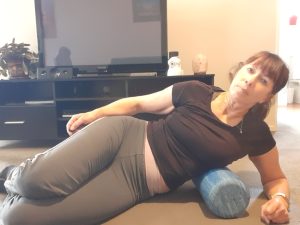
Breathing is one of the most neglected aspects of our well-being and ulimately one of the most effective stress reduction methods. But are you doing it right?
I bet you are thinking, well I must be doing it right or I wouldn't be alive right?
That is true. But many of us have not been taught how to breathe optimally, in a way that is more efficient and performed in a manner that will support our physical and mental health. I am seeing it increasingly more often in my clients and even in myself.
So why has breathing become more problematic?
- Lack of physical activity: Modern lifestyle has led us to sit more and spend a vast amount of time looking at screens. When you are hunched over you are more likely to compress the diaphragm and restrict lung capacity.
- Ineffective exercise programmes: Spending too much time training the chest muscles (press ups, bench press ect) and not working on the muscles in the posterior of the body can have the effect of restricting your diaphragm and intercostals.
- Chronic stress: Modern day life has led us to be more frequently under stress. Chronic stress causes the body to believe its in a survival situation, leading to rapid shallow breathing. This disrupts optimal breathing patterns and sends the nervous system into fight or flight.
- Anxiety: Being anxious causes us to breathe faster and less efficiently. This can disrupt the balance of oxygen and carbon dioxide in the blood.
- Air quality: if you are exposed to pollution from being stuck in traffic, vaping, cigarette smoke, toxic cleaning products,wood burner fumes or even mould this could change your breathing patterns.
- Sleep: if you have sleep issues such as Sleep Apnea, this will shift your breathing patterns overnight and spill into the daytime breathing.
- Mouth breathing: This is where people develop the habit of breathing in through their mouth instead of their nose. This can lead to dental cavities and increased susceptibility to infections as the nose is designed to filter out particles and viruses.
- Carrying excess weight: Having too much fat tissue around your diaphragm can restrict breathing and cause faulty breathing patterns
- Respiratory conditions: Having Asthma or COPD can disrupt normal breathing patterns.
- Structural deformaties: Scoliosis or sunken chest are two of the conditions that can cause sub-optimal breathing. This is what caused my breathing issues and I will get into how I fixed this shortly.
- It's important to mention that if you have a head cold it may become more difficult to breathe in through your nose, but this should be temporary.
When doing moderate or intense exercise the average person will shift to mouth breathing during that activity and that is totally normal.
How to change your breathing habits?
The first thing is awareness. It is very difficult to fix something that you are not conscious of. A good little test for you to do at home is to lie on your back with your knees bent. Place one hand on your tummy and the other hand on the upper chest. Take a deep breath in through your nose filling your tummy with air and expanding your lower rib cage.
In simple terms, if you feel your chest rise under your hand rather than your belly, it's likely that are you are not breathing optimally.

Practice makes perfect
Any new habits take a while to form. The key to changing things is to do it every day. Firstly concentrate on breathing in through your nose whenever you remember throughout the day. The more you think about it the more likely you are to catch yourself mouth breathing, especially if you are stressed.
I have invested a lot of time and effort on improving my breathing over the last year and it has made a significant difference to my well-being and it could do for you too. There are however, other parts at play.
Tissue restriction
As mentioned previously, if you are tight around the chest area and diaphragm, have any restrictions in the area caused by excess weight or abnormal conditions such as Scoliosis you may need help releasing the fascia (connective tissue) that has formed in that area which over time can just make that specific area literally stuck.
I had become aware that because of Scoliosis (abnormal curvature of the spine) I suffered quite a bit of restriction in my intercostals (an important respiratory muscle) on the left side of my body, so I noticed that I wasn't getting adequate expansion of my ribs on the left side.
How using a foam roller correctly helped fix restriction?
Foam rollers have been around for a while and I have used them with clients for years.But only recently, after completing an amazing course, did I discover a much more beneficial and effective way to use them. The traditional way of rolling a spot in your body actually has little effect on the fascia as its a very dense type of tissue. You have to create friction and movement to help shift the tissue. That combined with adequate hydration is key to help unstick tissue and it will take a while to adapt.
For me using the foam roller on a regular basis on my left rib, coupled with daily breathing practice, has made a dramatic difference to my ability to breathe more optimally.

I don't recommend you rush out,buy a foam roller and start rolling your ribs without professional supervision, as it can place stress on your nervous system and tissues if not done correctly.
What you can do at home to improve your breathing?
- Checking if your chest is rising when your breathe in through your nose lying on the floor. If it is keep practicing filling your tummy with air.
- Remind yourself when you are going about your day to breathe in through your nose rather than via mouth.
- A beneficial way is to time your breathing by taking 4 seconds to breathe in via your nose, holding up to 7 seconds and then breathe out through your mouth with pursed lips for as long as you can.
- Ideally you want your exhale to be twice as long as you inhale.
- If you feel yourself getting out of breath start with shorter intervals and build up.
- If you are overweight you may need to sit comfortably as the floor may be more challenging.
Other lifestyle modifications
- As mentioned previously hydrate adequately by drinking plenty of water.
- Move your body to keep the tissue moving more freely in as many different ways as possible.
- Be aware of your posture while working or using screens.
- Don't overdo chest exercises without properly addressing the opposing set of muscles.
- Manage stress by introducing meditation, getting fresh air and exploring nature.
- Reduce alcohol and sugar which contribute to stress, poor sleep and faulty breathing patterns.
If you need a more personalised approach to stress management and managing faulty breathing patterns then I would love to help.
